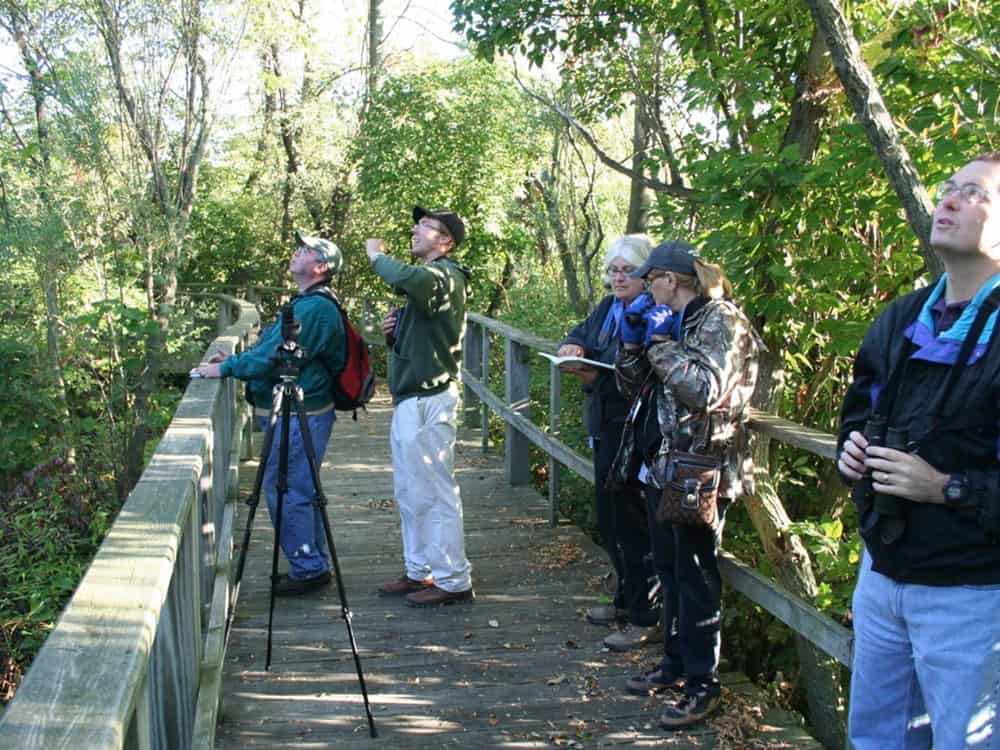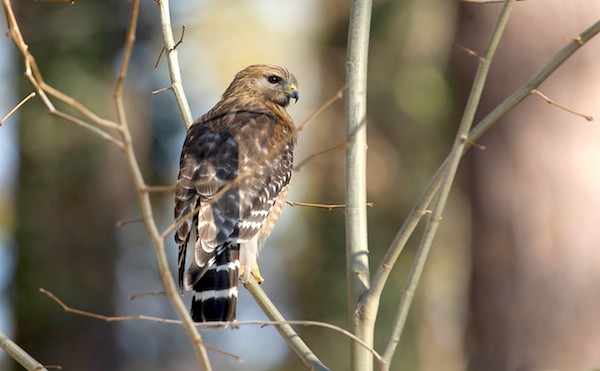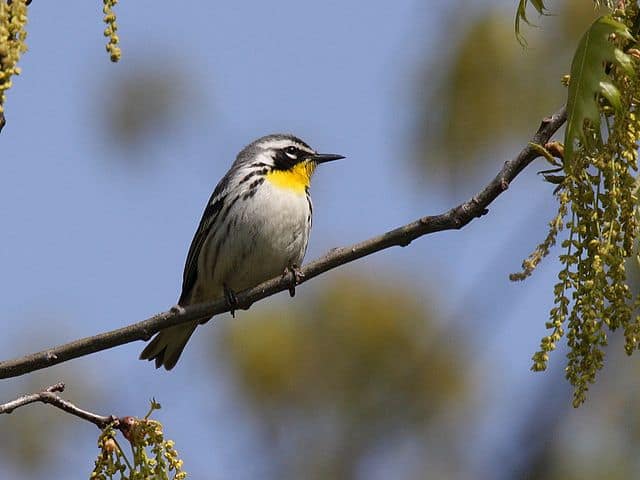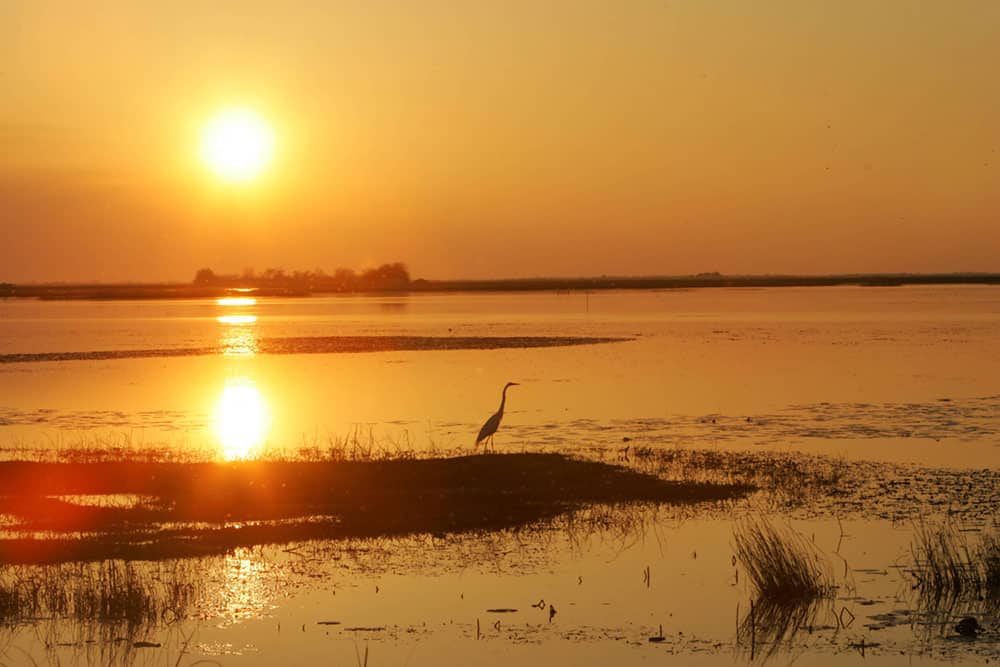Magee Marsh Wildlife Area
13229 West State Route 2
Oak Harbor, OH 43449
419-898-0960
This is may be the premier birding spot in Ohio. More than 300 species have been spotted on the wildlife area, and other great birding areas, such as Ottawa National Wildlife Refuge, surround it. Part of the vast western Lake Erie marshland ecosystem, Magee contains a diversity of wetlands, woodlots, and beaches that buffer the open waters of Lake Erie. The centerpiece of the site is the legendary “Bird Trail”. This half-mile long elevated boardwalk traverses a seven-acre swamp woods. Catch the right day in May, and the trees seem to fairly drip with brightly colored jewels – warblers, vireos, tanagers, orioles, grosbeaks, and others.
The main road through the wildlife area passes through one of the finest Ohio marshes, and ducks, geese, and other waterbirds abound and are readily observed from the roadway. Watch closely for American bittern; they are often seen along the road. Merlin and peregrine falcon are occasionally seen hunting over the marshes.
Magee is on a major hawk flyway, and March is the best time to observe this phenomenon. Not far from the interesting Sportsmen’s Migratory Bird Center is a large, elevated tower built specifically to enhance viewing of raptors passing overhead. This post offers a commanding view of the surrounding marshes, and on a good day, several hundred raptors might be tallied.
Big Island/Killdeer Plains wildlife areas
Olentangy Wildlife Unit
8589 Horseshoe Rd.
Ashley, OH 43003
740-747-2525
These two areas are only about seven miles apart, and occupy the southern edge of the Sandusky Plains, a former vast wet prairie whose remnants are largely preserved by these wildlife areas. Together, they total about 14,000 acres, and are easily combined into an interesting trip. There is great birding in all seasons, and a highlight of winter is the raptors. Northern harriers and rough-legged hawks are always around, and most years there are good numbers of short-eared owls flopping about the meadows. Bald eagles nest at both sites, and generally can’t be missed. Merlins are often seen in migration, and on occasion, a northern goshawk.
Shorebirds can also appear in large numbers at both areas, including large flocks of American golden-plover in April, and they are often in association with big flocks of Lapland longspurs. In autumn, mudflats attract more than two dozen species of shorebirds have been spotted, including both godwits, and American avocet.
Declining prairie and grassland birds can be plentiful in summer, such as dickcissel, sedge wren, Savannah and grasshopper sparrows, and sometimes western meadowlark and upland sandpiper.
Shawnee State Forest
13291 U.S. Route 52
West Portsmouth, OH 45663
740-858-6685
This is the largest contiguous forest in Ohio, covering over 63,000 acres. Sometimes referred to as the “Little Smokies”, a visitor can get a true sense of what the wilderness of Ohio must have been like in pre-settlement days. A network of lightly traveled forest roads bisect the area, and offer easy access to good birding locales. Be sure to get a map at forest headquarters; it’s easy to get lost here. Probably the biggest concentrations of forest breeding birds are found in Shawnee, and in some cases their numbers are staggering.
One might tally several dozen hooded warblers, or scarlet tanagers in a single morning. Woodland specialists like the worm-eating, cerulean, and Kentucky warblers are plentiful, and this is a good place to look for ruffed grouse, which sometimes stroll along the remote forest roads. As an added bonus, the botanical diversity is staggering – an estimated 1,000 species of vascular plants grow within the forest, including many rarities.
Hocking Hills
19275 State Route 374
Rockbridge, OH 43149
740-385-4402
This is a region of rugged hills and deeply incised valleys, and is one of the most scenic areas in the Midwest. Centered mostly in Hocking County, much of the Hocking Hills is protected by the Ohio Department of Natural Resources and is readily accessible to the visitor. In particular, Cantwell Cliffs and Old Man’s Cave state parks, and Conkle’s Hollow State Nature Preserve, are great places to get the flavor for this significant region. Hemlock gorges are the most prominent plant community, and this habitat makes for excellent birding.
Hemlock trees form dense stands on the steep slopes of cool, narrow ravines, creating a habitat much more common far to the north, and some very rare breeders for Ohio inhabit these sites. Specialty birds that can be found include black-throated green, Canada, and magnolia warblers, blue-headed vireo, and hermit thrush. Red-shouldered hawks are common in the area, as are ruffed grouse and pileated woodpeckers. A great diversity of woodland songbirds can be found in the forests, including cerulean and hooded warblers, both tanagers, and Carolina wrens.
The Edge of Appalachia Preserve
3223 Waggoner Riffle Rd.
West Union, OH 45693
937-544-2188
The Nature Conservancy and Cincinnati Museum have worked together to protect over 15,000 acres of woodlands, prairies and streamside forest along the scenic Ohio Brush Creek in Adams County. Birding here is outstanding, particularly in spring and summer, when breeders are on territory. Keep your eyes overhead, too – this is one of the few Ohio strongholds for black vulture. An evening expedition along Waggoner Riffle Road, which borders the creek, is sure to produce calling chuck-will’s-widow and perhaps barred, eastern screech-owl, and great horned owls.
The woods are alive with breeding warblers and other neotropical songbirds, and species that favor mature woodlands, including black-and-white warbler, wood thrush, and summer tanager. Open, brushy fields festooned with red cedar are common in the area, and these sites harbor plenty of prairie warblers, yellow-breasted chats, white-eyed vireos, and the occasional blue grosbeak. Some of the more open fields have small colonies of Henslow’s sparrows.
Oak Openings Metropark
4139 Girdham Rd.
Swanton, OH 43558
419-826-6463
This is one of the most significant habitats in Ohio and quite unique – more species of rare plants are found here than anywhere else in the state. Along with unusual plant communities come unusual birds, and this is the only locale where lark sparrows can be found, and also one of the only regular breeding haunts for Wilson’s snipe, best found at Irwin Prairie State Nature Preserve. Traveling through the area at night should produce calling whip-poor-wills, along with our common owls, and numerous displaying American woodcock.
The Oak Openings is known for harboring more southern species of birds that are very rare elsewhere in northern Ohio, including blue grosbeak, summer tanager, and pine warbler. In fall, many raptors migrate around the western end of Lake Erie and travel directly over the Oak Openings, and this area is the best spot to look for migrant golden eagles.
The Wilds
14000 International Rd.
Cumberland, OH 43732
740-638-5030
Upon first view of this sprawling grassland that carpets the rolling hills, many visitors are dazzled, as the landscape more resembles an African savanna than any Ohio habitat. The Wilds covers some 8,000 acres, and is surrounded by about 20,000 acres of similar habitat. While birding can be good at any season, The Wilds is legendary for its wintering raptors. Traveling the roads that bisect the area is sure to produce many northern harriers and rough-legged hawks, including the rarer dark phase rough-legged.
Short-eared owls are always present, and in some years even stay to breed. In some years, more than 50 of these grassland owls have been present, and as they are often active in daylight hours, observation of them can be easy. In recent years, several golden eagles have overwintered, and these huge raptors are frequently spotted. The pinnacle of exciting raptors was reached in February, 2004, when a prairie falcon appeared and was widely seen, then reappeared in late fall of 2004!
In summer grassland breeders, including bobolinks and eastern meadowlarks, are absolutely abundant, and less-extroverted birds like grasshopper and Savannah sparrows are common. Henslow’s sparrows occur commonly throughout the area. Tangles of autumn-olive and black locust support lots of orchard orioles, indigo buntings, and yellow-breasted chats.
Crown City Wildlife Area
Waterloo Wildlife Unit
9650 State Route 356
New Marshfield, OH 45766
740-664-2745
This is one of Ohio’s newer wildlife areas, acquired in 1997 by the Ohio Division of Wildlife. Sprawling over nearly 12,000 acres of reclaimed strip mine grasslands interspersed with undisturbed pockets of forest, Crown City is packed with interesting breeding birds. It is most famous for the staggering numbers of blue grosbeaks that nest here. This southerner is rare in Ohio and usually encountered as single birds here and there, but at Crown City they are sometimes the dominant singer and more than 20 pairs can be present.
Henslow’s sparrows are plentiful, and in good years several dozen dickcissels are on territory. Shrub-lovers like prairie warbler and white-eyed vireo are common in thickets. The small pockets of forest scattered around the site have a surprising diversity of woodland species, including cerulean and Kentucky warblers, wood thrush, orchard oriole, and scarlet tanager.
Mohican State Forest
Division of Forestry
2205 Reiser Ave. SE
New Philadelphia, OH 44663
330-339-2205
The gorgeous Clear Fork of the Mohican River cuts through the center of this 5,000 acre forest, and dense stands of hemlock trees festoon the steep slopes along the stream. Many northern species breed here, the bulk of whose populations occur far to the north of Ohio. Black-throated green warblers are the most numerous of these northern species, and their wheezy songs are a common sound through the forest. It isn’t too hard to find breeding blue-headed vireos, hermit thrushes, magnolia warblers, and purple finches, and occasionally Blackburnian and mourning warblers, and winter wren. More common woodland nesters are plentiful, and this is surefire place for pileated woodpecker, ovenbird, scarlet tanager, and hooded warbler. Both black-billed and yellow-billed cuckoos also nest.
Mohican is well worth a winter trip, too, as the extensive plantations of red and white pine often attract northern birds heading south from the Canadian boreal forest. Purple finches, red-breasted nuthatches, and pine siskins are often common, and in flight years, evening grosbeaks can be found. Sometimes, either red or white-winged crossbills show up.
Headlands Dunes State Nature Preserve
Division of Natural Areas and Preserves
2045 Morse Rd, F-1
Columbus, OH 43229
614-265-6453
This 25-acre preserve contains the best remaining example of a naturally vegetated Lake Erie beach in Ohio. The gently undulating dunes carpeted with American beach grass and coastal little bluestem are worth the journey in their own right, but this site is also a birder’s paradise-well in excess of 300 species have been found at Headlands. A small, scruffy patch of woods near the parking lot is a beacon for migrant songbirds. Many warblers can be spotted on a good day, along with many species of thrushes, sparrows, and other land birds.
Several species of gull, including great black-backed gull, often loaf along the shore, and sanderlings and ruddy turnstones are regular on the beach. The long, rocky breakwall that separates the preserve from Fairport Harbor to the east is probably the most reliable Ohio locale for two rare shorebirds, the purple sandpiper and red phalarope. Most winters, snowy owls are found perching on the breakwalls, too. The sheltered waters of the harbor are a real draw for ducks, including most of the diving species like greater scaup, bufflehead, and red-breasted merganser. This is also an excellent winter locale for finding all three scoters and harlequin duck.




